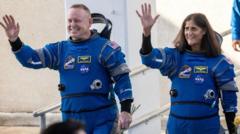As they approached the ISS, technical failures prevented their Boeing Starliner capsule from docking, raising serious concerns about their return to Earth. “If we weren't able to dock, would we be able to make it back?” Wilmore shared months after their eventual landing. Fortunately, Mission Control helped them regain control of their thrusters, leading to a successful docking minutes later.
Reflecting on the ordeal, both astronauts noted that while doubts about their situation crossed their minds, they remained focused on finding solutions. Williams emphasized their training allowed them to communicate non-verbally during tense situations, working together to address multiple unexpected failures.
Their mission, initially set for June 2024, faced hurdles that ultimately rendered the Starliner unsafe for return. Instead, the astronauts were transported back via a SpaceX capsule once NASA determined it was the safest option. Despite various technical issues, Boeing maintained the Starliner was viable, a claim supported by the successful uncrewed mission that followed.
Once back on Earth on March 18, both astronauts expressed their gratitude for the support they received. They also shared insights about their daily exercise regimens in space that kept them fit during their extended mission. The astronauts noted how physical activity helped them return from orbit in excellent health, although readjusting to gravity presented its challenges.
Post-mission, both Wilmore and Williams resumed collaboration with NASA and Boeing to rectify the issues that plagued their flight. They remain optimistic about the Starliner's future potential in human spaceflight, with Williams declaring her confidence in the spacecraft’s capabilities.
Looking back on their time in orbit, both astronauts assert that they’d willingly fly in the Starliner again once improvements are made, highlighting the spacecraft’s unique strengths compared to its counterparts. As they move forward, they continue to advocate for the future of space exploration and human spaceflight.
Reflecting on the ordeal, both astronauts noted that while doubts about their situation crossed their minds, they remained focused on finding solutions. Williams emphasized their training allowed them to communicate non-verbally during tense situations, working together to address multiple unexpected failures.
Their mission, initially set for June 2024, faced hurdles that ultimately rendered the Starliner unsafe for return. Instead, the astronauts were transported back via a SpaceX capsule once NASA determined it was the safest option. Despite various technical issues, Boeing maintained the Starliner was viable, a claim supported by the successful uncrewed mission that followed.
Once back on Earth on March 18, both astronauts expressed their gratitude for the support they received. They also shared insights about their daily exercise regimens in space that kept them fit during their extended mission. The astronauts noted how physical activity helped them return from orbit in excellent health, although readjusting to gravity presented its challenges.
Post-mission, both Wilmore and Williams resumed collaboration with NASA and Boeing to rectify the issues that plagued their flight. They remain optimistic about the Starliner's future potential in human spaceflight, with Williams declaring her confidence in the spacecraft’s capabilities.
Looking back on their time in orbit, both astronauts assert that they’d willingly fly in the Starliner again once improvements are made, highlighting the spacecraft’s unique strengths compared to its counterparts. As they move forward, they continue to advocate for the future of space exploration and human spaceflight.




















